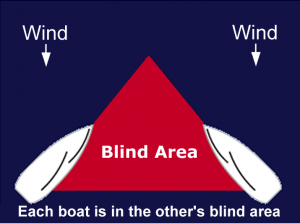When you operate a sailboat, just like when you drive a car, it’s important to know who has the right-of-way under different circumstances. There are way more rules than I am going to cover here because this blog is geared toward the casual boater, but I will go through some of the basics, so you can be safe until you learn all of the rules.
First of all, try to remember that reasonably speaking the vessel with the least maneuverability in any situation, pretty much has the right-of-way, and the vessel with the most maneuverability should avoid the other because it can.
A boat being powered by sail almost always has the right of way over a boat being propelled by an engine (including if the boat being propelled by an engine has sails). The logic is simple; wind direction and speed limit how a sail-powered boat can maneuver, and a boat being pushed by a motor does not have those same restrictions. There are a couple of notable exceptions. Really large power boats do not have the same ability to maneuver as smaller power boats. I have sailed many enjoyable hours in San Diego Harbor, where large Naval and commercial ships are a part of every day boating life. Those large ships are not going to be able to alter course or speed in time to avoid a small sailboat, so always stay out of their way.

Photo Credit: Me
If any boat is honking a horn at you, there is a very good chance they don’t believe they can safely avoid you… maybe they are a large ship, or maybe they are similar to your size, but their engine died or their steering is not operating properly. If you hear a horn, instead of yelling at the other boat, assess the situations to see if they may be directing the horn at you, and if so, take evasive action immediately to avoid a collision.
Next, anytime you are overtaking (passing from behind) another boat, the boat overtaking must stay clear of the boat they are passing. Clearly you have (or are using) more power than them, so you should stay a safe distance.
If two powerboats are about to meet in a head-on (or near head-on situation), both boats are required to adjust their coarse to starboard (for you casual boaters who are not clear on these terms yet port and left both have a ‘t’ at the end and are both four letters, so they are the same), however, if two sailboats are about to meet head-on, the boat with the wind coming over her starboard (right) side should not alter course or speed; it is the stand-on vessel and the other boat should give way (making it the give-way vessel). To help you remember this, think “right is right” so that if the wind is on the right side of your sailboat, you have the right-of-way. See this is a case where both vessels theoretically could be evenly matched in maneuverability, so someone had to be the winner, like when two cars arrive at a 4-way stop at the same time.
Your sails sometimes reduce the vision of the person at the helm (wheel or tiller). Keep this in mind as well when determining whether you will give-way or stand-on. It does not change who actually has the right of way, but it could save you from having a problem. If you are operating a sailboat and the boat has blind spots because of sails, make sure you have someone responsible in a location on the boat where they will help you see what might be hiding there and remember that if you are in their blind spot, even if you have the right-of-way, you may need to adjust because they might not see you.

Keep a portable airhorn handy because you, alone, may not be able to avoid a collision, and you may need to alert the other vessel of this.
There may be times when you could barely change course and still feel confident that you will avoid the stand-on vessel, but they may not notice a small course change, so for the comfort of the other skipper and all on board that boat, make a substantial course change; one that makes it obvious to them that you are doing they right thing, so that they can relax and enjoy more of their day out on the water.
Of course, whether in a car or on the water, never insist on the right of way to your detriment. It is everyone’s responsibility to avoid a collision and if there is a collision on the water, the insurance companies usually state that all vessels involved had at least some share of the blame. Plus if the other guy is an idiot, it shouldn’t ruin your whole day (or several weeks waiting for your vessel to be repaired). Finally, I implore you to please really know the rules before you take the helm of any sailboat.
Fair Winds
Captain Jeff Vegas
 Terms of Use
Terms of Use
Leave a Reply